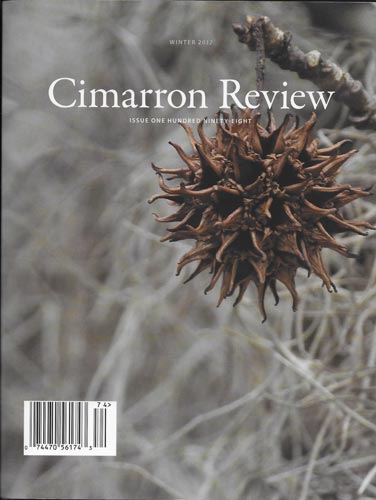Cimarron Review – Winter 2017
With prosy poems and poetic prose, Cimarron Review provides fodder for intelligent readers. Founded in 1967 and a member of CLMP, the magazine regularly nominates its writers to “notable contests.” The Winter 2017 issue is a clean, slim volume, the pages almost square and formatted with a lot of white space so the reader can breeze through. Of the 25 writers, 14 are male, and a different 14 had published one or more books, while 8 were either MFA graduates without publications, or had published in fairly-unknown magazines.
With prosy poems and poetic prose, Cimarron Review provides fodder for intelligent readers. Founded in 1967 and a member of CLMP, the magazine regularly nominates its writers to “notable contests.” The Winter 2017 issue is a clean, slim volume, the pages almost square and formatted with a lot of white space so the reader can breeze through. Of the 25 writers, 14 are male, and a different 14 had published one or more books, while 8 were either MFA graduates without publications, or had published in fairly-unknown magazines.
Most of the poetry in this issue leans toward spare prose, sometimes based on a vivid anecdote that leaps deftly into philosophy. For example, Karen Skofield’s “Abbreviated Guide to Unusual Phobias” begins with a wry list of eccentric fears posed as questions, “If I abide crowds but not the man in the fringed vest . . . If children are welcome but identical twins cause sweating.” Then it builds to fears that have shaped civilization: “The fear that I will outlive / my children is called parenting” and “A fear that the lion will never lie down with the lamb / is called Revelations . . . ”
Michael T. Young’s “High Dive” explores how body and mind navigate the laws of gravity, while Michelle Menting and Katharine Kaufman’s poems enter and exit dreams. Amy O’Reilly’s poem “Girls in the City” paints a vivid picture of girls playing sidewalk games that grow into adult despair:
Like so many girls
who become bigger girls. Fish in dim,
shallow bowls. Their suns,
wounds in the sky’s flesh
Just when you think you’ve figured out this magazines’ prosy esthetic, it springs a few poems on you which experiment with form, like Doug Ramspeck’s “Field Anatomy,” which is formatted like a double-spaced prose poem, but is written with choppy syntax and juxtaposed images, or a highly abstract poem, like Michael Hurley’s “Samuel Explains Departure”:
It will discredit you
to look too longingly
at a thing like this,the way a laugh is
half
for the other person.
The poems make you work some, but not too hard before they yield rewards, which is always my personal preference.
In addition to the 25 poems, there are four short stories and two essays. The stories range between 8 and 14 pages, some straight up realism, and two that challenge.
Jessica Hollander’s “Oracle,” explores a relationship from a man’s point of view, whose emotions flicker on and off like the streetlight outside his apartment at twilight “nervous about its judgment.” It finishes with a de rigueur unresolved but thought-provoking ending. Miriam Cohen’s realistic “Wife” deals with an old story in a vivid yet humble way, a woman’s rage at being cheated on, while William Haas narrates the downward mental spiral of a “One-Hit Wonder” in prose that is dense and logic defying.
My favorite was Michael Biel’s “La Négresse,” narrated in first person, which starts out seemingly realistic, but gets stranger and stranger. The first-person narrator tells the unlikely story of twins who turn out to be doppelgängers, who join him at a café in France. Narrated in tongue-in-cheek, false-British style, using words like “moue,” “chap,” and “a frisson of delight,” the narrator wanders farther and farther afield of logic, with observations, like, “I would have despaired of telling the two apart had I not noticed almost right from the start that Jack was right-handed and Jed was left . . . Shouldn’t all Jacks be left-handed? Marys right and Marthas left?” I’m not sure I understood it, but I think it’s a send-up of narcissism.
That leaves me with the two essays. Both are richly figured, written by men dealing with male issues in not particularly male ways. “If It Had to Perish Twice,” contrasts childhood vignettes with adult vignettes to explore the complexity of intentional and unintentional racism and aggression. “A Man of Action” features the aggressions latent in a relationship of father and son.
Issue 198 of Cimarron Review delivers highly but subtly crafted mainstream writing with some boundary pushing pieces that provide fodder for the intelligent reader without demanding more than their due.
[www.cimarronreview.com]





